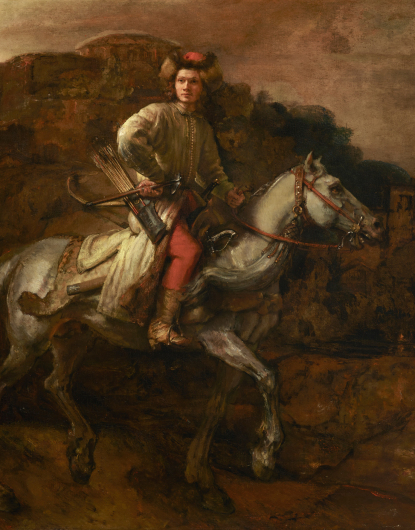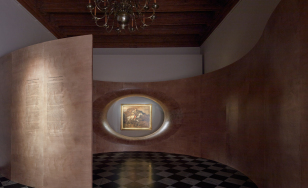The King’s Rembrandt at Wawel Castle: "The Polish Rider" from The Frick Collection
August 18-October 16, 2022
A special presentation of The Polish Rider from the Frick Collection in New York at the Wawel Royal Castle
A special presentation of The Polish Rider from the Frick Collection in New York at the Wawel Royal Castle
Art lovers in Poland are in for a rare treat this year, Rembrandt’s Polish Rider from the Frick Collection in New York, first exhibited at the Royal Łazienki Museum in Warsaw, soon will be presented at Wawel Royal Castle in Krakow. These two museums are the only European institutions that showed Rembrandt’s masterpiece, which is closely linked to Polish history. The presentation at Wawel Castle will take place from August 18 to October 16, 2022.

Rembrandt Harmenszoon van Rijn (1606–1669)
The Polish Rider
—
ca. 1655
Oil on canvas, 117.1 × 134.8 cm
The Frick Collection, New York, acc. no. 1910.1.98

The Polish Rider, painted in about 1655 by Rembrandt Harmenzsoon van Rijn (1606–1669) is probably one of the Old Master’s most mysterious and enigmatic pictures. Not only because it is one of just two images of riders in the artist’s oeuvre, the other being the Portrait of Frederick Rihel on Horseback in the National Gallery in London. It has intrigued scholars since 1883, when Wilhelm von Bode introduced it into the art historical literature. Connoisseurs and lovers of Rembrandt’s work first saw the painting in 1898 in a monographic exhibition of 130 of the Leiden master’s pictures in the newly-opened Stedelijk Museum in Amsterdam. Count Zdzisław Tarnowski of Dzików thought long and hard before responding to the loan request from Abraham Bredius, one of the exhibition’s organizers, and finally agreeing to send the Polish Rider to Amsterdam. Nevertheless, twelve years later he sold the picture to the New York collection of Henry Clay Frick, where it remains to this day.
When King Stanislaw II August Poniatowski received the Rembrandt and hung it in his picture gallery in the Łazienki Palace on the Isle in Warsaw, it was called the Cossack on Horseback. Michał Kazimierz Ogiński, the donor, wrote to the king: “I am sending Your Majesty a Cossack that Rembrandt has sat on a horse, which horse has, in his time with me, eaten me out of 420 German guldens....” It is highly likely that in this lighthearted manner Ogiński revealed the price he had paid for the picture, but mentioned neither where nor from whom he acquired it. The Rembrandt remained in the king’s collection even after he abdicated in 1795. In 1814 Franciszek Ksawery Drucki-Lubecki bought the picture and promptly sold it to Bishop Hieronim Stroynowski. Stroynowski died a year later. It remained in the bishop’s family until 1834, when his niece Waleria Stroynowska brought it as part of her dowry into her marriage to Jan Feliks Tarnowski. In the Stroynowski family the Cossack on Horseback became a family portrait—Waleria saw in it a resemblance to Stanisław Stroynowski, commander of Aleksander Lisowski’s legendary regiment. It is possible that some recognized in the rider a similarity to the Lisowczyk described by the formation’s chaplain, the Franciscan Wojciech Dembołęcki. Writer Kajetan Koźmian popularized the term “Lisowczyk” in 1842, while Rafał Stroynowski immortalized the romantic legend in an article published in 1856 in the Gazeta Warszawska. In the Amsterdam exhibition of 1898, the picture was already titled the Polish Rider.

Rembrandt scholars noticed fairly early on that the rider’s dress and equipment are unusual and unique in the artist’s oeuvre. This cannot be explained simply by the fact that the artist had in his workshop numerous elements of Oriental dress and arms, which he often used in his compositions. Zdzisław Żygulski, Jr. demonstrated that the details of the rider’s costume, the type of arms he carries, his seat (the way his body is positioned on the horse), and even the breed of his mount, indicate that the picture is a likeness of a Polish light cavalry officer, and hypothesized that Rembrandt portrayed a specific individual. How else could one explain the fact that a painter unaware of Polish styles and customs, so realistically and unfailingly represented the padded and quilted zhupan (coat), which functioned as a type of “soft armor,” leather boots, tight red trousers, and the fur-trimmed hat. How would he have known what a horseman’s pick—a type of war hammer with a very long spike which also functioned as an officer’s symbol of authority—looked like? Or how to correctly place the bow in its case on the left and the quiver full of arrows on the right? Did he have Polish swords and sabers among his many different studio props? The one visible under the rider’s right knee is a koncerz, a type of long and narrow thrusting weapon typically used by the Polish hussars, a heavy cavalry formation, but also occasionally by the light cavalry. The hilt of the other is just visible at the rider’s left hip. The small saddle, the leopard skin, and the bridle with a horsehair tassel attached complete the exceptionally well-matched ensemble in terms of form, function, and style.
All of these details could indicate that the picture does, indeed, portray a Lisowczyk, were it not for the fact that the military formation, which gained fame for its valor as well as notoriety for raping and pillaging, was disbanded in 1635 while the painting was executed some twenty years later.
Joanna Winiewicz-Wolska, Ph.D.

The Polish Rider is not a uniform work. Perhaps it was unfinished, and later additions were made by a different hand in a manner inconsistent with the artist’s original intention. Certain imperfections, which may have resulted from overcleaning or the addition of a narrow strip of canvas at the lower edge, coupled with inconsistencies in the handling of the horse, made scholars question the attribution to Rembrandt. Nevertheless, the remaining areas of the composition, especially the meticulously rendered elements of the rider’s costume and equipment on which the painter focused his attention, exhibit the virtuosity of his brush. The bold streaks of pure color, passages heightened with white where the light falls from the left—such as the gleaming metal of the hilt and horseman’s pick, the arrows in the quiver, and the shiny fabric of the zhupan on the right sleeve—decisively speak to Rembrandt’s authorship. The picture was executed around the same time that Rembrandt painted the Landscape with a Castle (Louvre, Paris) and the Parting of David and Jonathan (Hermitage Museum, Saint Petersburg). A common trait present in all three works is the background composition featuring an unidentified building with a flattened dome. Set on a hill down which a small waterfall flows into a narrow stream at the horse’s feet, the dark plane of the building stands out against the light-colored sky and provides a the backdrop for the brightly lit central scene. The horse walks slowly, the rider turns his head and gazes into the distance.
The picture was painted as Rembrandt’s brilliant career was on the wane and the artist was facing bankruptcy. Although he was still receiving commissions, their numbers were no longer what they had been. His self-portraits from this period reveal a face harrowed by worry and the passage of time. In what circumstances did he paint the Polish Rider? Could it be a portrait of a Polish nobleman whom Rembrandt may have met in Amsterdam? Or did the artist portray, dressed alla polacca, the prodigal son, who as he leaves his father’s home crosses a river—the symbolic boundary between his old and new life? Perhaps this is a Miles Chrisitianus, a Soldier of Christ, armed for battle against the infidel? Is he a biblical figure? The artist’s son Titus? It is quite likely that we will never know...
Joanna Winiewicz-Wolska, Ph.D.
The picture was painted as Rembrandt’s brilliant career was on the wane and the artist was facing bankruptcy. Although he was still receiving commissions, their numbers were no longer what they had been. His self-portraits from this period reveal a face harrowed by worry and the passage of time. In what circumstances did he paint the Polish Rider? Could it be a portrait of a Polish nobleman whom Rembrandt may have met in Amsterdam? Or did the artist portray, dressed alla polacca, the prodigal son, who as he leaves his father’s home crosses a river—the symbolic boundary between his old and new life? Perhaps this is a Miles Chrisitianus, a Soldier of Christ, armed for battle against the infidel? Is he a biblical figure? The artist’s son Titus? It is quite likely that we will never know...
Joanna Winiewicz-Wolska, Ph.D.
Exhibition Co-organizer

Exhibition Partner

Light installation


Exhibition Partner

Light installation














